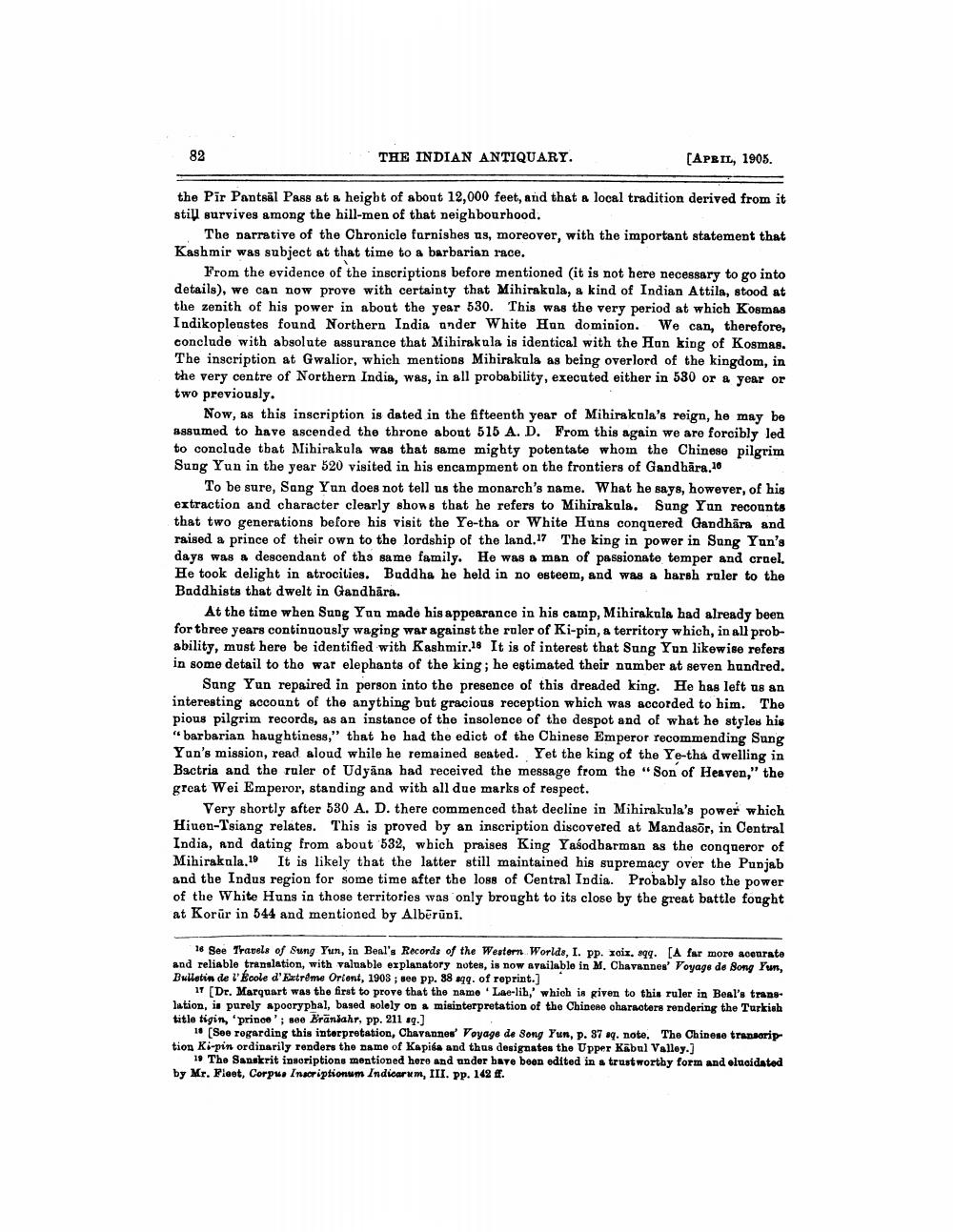________________
82
THE INDIAN ANTIQUARY.
[APRIL, 1905.
the Pir Pantsal Pass at a height of about 12,000 feet, and that a local tradition derived from it still survives among the hill-men of that neighbourhood.
The narrative of the Chronicle furnishes us, moreover, with the important statement that Kashmir was subject at that time to a barbarian race.
From the evidence of the inscriptions before mentioned (it is not here necessary to go into details), we can now prove with certainty that Mihirakula, a kind of Indian Attila, stood at the zenith of his power in about the year 530. This was the very period at which Kosmas Indikopleustes found Northern India ander White Han dominion. We can, therefore, conclude with absolute assurance that Mihirakula is identical with the Hun king of Kosmas. The inscription at Gwalior, which mentions Mihirakula as being overlord of the kingdom, in the very centre of Northern India, was, in all probability, executed either in 530 or a year or two previously.
Now, as this inscription is dated in the fifteenth year of Mihirakula's reign, he may be assumed to have ascended the throne about 515 A. D. From this again we are forcibly led to conclude that Mihirakula was that same mighty potentate whom the Chinese pilgrim Sung Yun in the year 520 visited in his encampment on the frontiers of Gandhara.10
To be sure, Sang Yun does not tell us the monarch's name. What he says, however, of his extraction and character clearly shows that he refers to Mihirakula. Sung Yun recounts that two generations before his visit the Ye-tha or White Huns conquered Gandhara and raised a prince of their own to the lordship of the land. 17 The king in power in Sung Yun's days was a descendant of the same family. He was a man of passionate temper and cruel. He took delight in atrocities. Buddha he held in no esteem, and was a harsh ruler to the Buddhists that dwelt in Gandhara.
At the time when Sung Yun made his appearance in his camp, Mihirakula had already been for three years continuously waging war against the ruler of Ki-pin, a territory which, in all probability, must here be identified with Kashmir.18 It is of interest that Sung Yun likewise refers in some detail to the war elephants of the king; he estimated their number at seven hundred.
Sung Yun repaired in person into the presence of this dreaded king. He has left us an interesting account of the anything but gracious reception which was accorded to him. The pious pilgrim records, as an instance of the insolence of the despot and of what he styles his "barbarian haughtiness," that he had the edict of the Chinese Emperor recommending Sung Yun's mission, read aloud while he remained seated. Yet the king of the Ye-tha dwelling in Bactria and the ruler of Udyana had received the message from the "Son of Heaven," the great Wei Emperor, standing and with all due marks of respect.
Very shortly after 530 A. D. there commenced that decline in Mihirakula's power which Hiuen-Tsiang relates. This is proved by an inscription discovered at Mandasor, in Central India, and dating from about 532, which praises King Yasodharman as the conqueror of Mihirakula.10 It is likely that the latter still maintained his supremacy over the Punjab and the Indus region for some time after the loss of Central India. Probably also the power of the White Huns in those territories was only brought to its close by the great battle fought at Korur in 544 and mentioned by Alberūni.
18 See Travels of Sung Yun, in Beal's Records of the Western Worlds, I. pp. xoix. sqq. [A far more accurate and reliable translation, with valuable explanatory notes, is now available in M. Chavannes' Voyage de Song Yun, Bulletin de l'École d'Extrême Orient, 1908; see pp. 88 sqq. of reprint.]
17 [Dr. Marquart was the first to prove that the name Lae-lib,' which is given to this ruler in Beal's translation, is purely apocryphal, based solely on a misinterpretation of the Chinese characters rendering the Turkish title tigin, 'prince'; see Eraniahr, pp. 211 sq.]
18 [See regarding this interpretation, Chavannes' Voyage de Song Yun, p. 37 sq. note. The Chinese transoription Ki-pin ordinarily renders the name of Kapisa and thus designates the Upper Käbul Valley.]
19 The Sanskrit inscriptions mentioned here and under have been edited in a trustworthy form and elucidated by Mr. Fiest, Corpus Inscriptionum Indicarum, III. pp. 142 ff.




